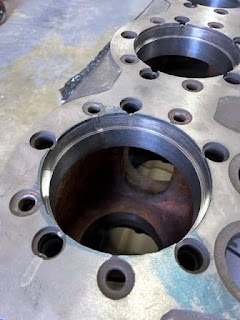While the amount of work still required on both the locomotive and the main engine shell should not be underestimated, much of what we need to do on both aspects of the project is graft. The fuel pump and governor assembly is the last big challenge as it is a complex box of tricks and while we have made good progress with the box (casting complete, as blog entry 19 January 2023), there are a lot of components to go inside it; 90 according to the McLaren spares catalogue (see blog entry for 10 February 2020).
The casting for the body is currently with John Dunn Engineering for machining.
The blog entry for 16 February 2023 described the progress made in producing new injectors. To function the injectors need fuel pumps. Unlike the injectors we have not been able to source any drawings and there has been a lot of patient backroom work going on to clone these high spec, close tolerance units from the samples borrowed from the MDB2 engine.
The role of the pumps is to deliver a measured amount of fuel to the injectors, at a pressure which is sufficiently high to be injected into the cylinder at the top of its compression stroke. In the case of the MBD4, the fuel is injected at 1,000 psi.
The work carried out by Grange Square Engineering on the injectors was impressive, in terms of price, quality and timescale and we had no hesitation in asking them to quote for the fuel pumps too. As you will have probably gathered from previous reports, finding suppliers who are interested in manufacturing small batches of intricate components can be challenging. The relief in placing an order with a Company, knowing that they will do what you want in a realistic timescale was enormous.
The extract below is from a spares catalogue for MDB2 engines. The columns are ‘Part Number’, ‘6’ is the illustration number (the relevant part of which is reproduced) with the final column being the number off required (for a two-cylinder engine).
Only eight bits, but they do need to be right, exactly right if there are to do the job. The original pump bodies (part No 595) were forgings. While we are particular about how things are made, four forgings is never going to happen and Grange Square have CNC machined these from solid. It looks like there must have been a lot of swarf produced relative to the component size.
Machining the body for one of the fuel pumps (McLaren spares number 595) (image courtesy of Grange Square Engineering)
Replica fuel pump (left) with original fuel pump (right) borrowed from the MDB2 engine.
Another challenging component is the rack which lifts the cam followers which drive the pumps. The arrangement of this rack is different in concept of the MDB2 engine which is our primary source of reference to the one fitted to the MDB4 engine in the Armley Mills winch. We’ve taken our lead from the MDB4 engine. Grange Square has manufactured the new rack from the solid rather than the original forging. It may be politically incorrect to say ‘can you see what it is yet?' But you may need to look at the final illustration to understand the machining process shown in the three photos below.
The end of the rack appearing out the block (Grange Square Engineering)
Radiusing the arm corners (Grange Square Engineering)
A lot of swarf later and things are shaping up (Grange Square Engineering)
The finished product.
So, nine bits done, 81 bits to go!























